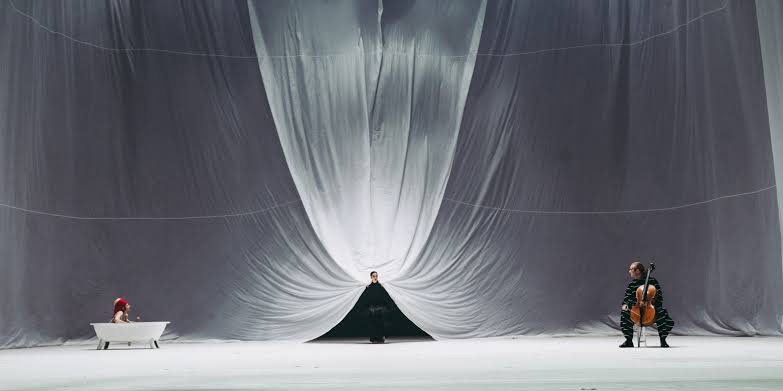Ad aprile si celebra il balletto all’Opera di Parigi e di Stoccolma
Da 'La Bayadère' dell'Opera della Bastille a 'Escapist' della Royal Swedish Opera di Stoccolma l'Europa onora il balletto come viaggio dal potere unificatore.

Da 'La Bayadère' dell'Opera della Bastille a 'Escapist' della Royal Swedish Opera di Stoccolma l'Europa onora il balletto come viaggio dal potere unificatore.

(English translation below)
L’Opera della Bastille a Parigi rappresenta uno dei capolavori dell’architetto canadese-uruguaiano Carlos Ott. Nel 1983, quest’ultimo vince una competitiva selezione per la progettazione di questa struttura dalle facciate trasparenti, con un aspetto particolare per via dell’uso degli stessi materiali per l’interno e l’esterno, finendo i lavori e inaugurando l’Opera nel 1989.
L’esperienza che offre l’Opera della Bastille è unica per il posizionamento acusticamente coerente dei 2700 posti a sedere, le scenografie integrate al palco, le strutture sceniche particolari, i costumi, gli accessori e ben altro che rendono questo spazio uno dei più grandi teatri moderni in Europa. In poche parole, l’esperienza all’Opera della Bastille a Parigi è incomparabile.
In questo spazio, fino al 6 maggio, il pubblico è invitato a La Bayadère, nome originale Il Danzatore del Tempio, in russo Баядеpка (bayaderka), un balletto messo in scena in quattro atti e sette quadri dal coreografo francese Marius Petipa, accompagnato dalla musica di Ludwig Minkus.
La Bayadère fu eseguita per la prima volta dall’Imperial Ballet all’Imperial Bolshoi Kamenny del Teatro di San Pietroburgo nel 1877. Da allora, rimane un’opera famosa per la scena Il Regno delle Ombre, uno degli estratti più recitati e celebrati nel balletto classico.
Un dramma che risuona tradizioni e culture proprie a diversi paesi euroasiatici. La Bayadère narra la storia delle avventure di Nikiya, una bayadère, e del guerriero Solor, i quali si promettono fiducia e insieme dovranno affrontare diverse sfide.
Questo viaggio morale e inter-relazionale è raccontato attraverso l’eleganza dei movimenti eseguiti da Le Stelle, i ballerini principali e il Corpo di Ballo dell’Opera, accompagnati da altri allievi della Scuola di Danza del teatro.
Questo viaggio melodico non solo rivela narrative antiche, ma risveglia una nuova concettualizzazione della messa in scena classica e tradizionale nello sperimentare tecniche moderne. Riscriviamo il ruolo della cultura, del balletto, dell’opera e del teatro, usiamo il loro potere unificatore per ricordarci la bellezza del diverso in giorni di guerra.
In parallelo al carisma dell’Opera della Bastille a Parigi, troviamo l’Opera Reale Svedese, nome originale Kungliga Operan, un’opera e compagnia di balletto con sede a Stoccolma, capitale svedese.
Situata nel cuore del centro politico, storico e culturale della capitale, l’Opera Reale Svedese fu fondata nel 1773. Nel 1892, il teatro fu demolito per via di problemi di conservazione, causando lo spostamento della sede varie volte ma sempre mantenendo il suo prestigio nell’ambito della musica classica e dell’opera lirica.
Fino al 23 aprile, questo palcoscenico storico invita il pubblico ad assistere a Escapist, un balletto messo in scena dal coreografo Alexander Ekman. Escapist si rivela nell’astratto, nel dirigere l’attenzione al di fuori della realtà, mettendosi in connessione con il potere dell’immaginazione.
Siamo tutti escapists, nei desideri odierni, coscienti o meno, di allontanarci dalla realtà quando ascoltiamo musica, sogniamo di giorno, guardiamo un film o semplicemente immaginiamo ciò che non c’è, che perciò comincia la sua esistenza.
Nell’esplorazione di questo mondo subliminale, il pubblico è invitato dall’Opera Reale Svedese a continuare questo viaggio insieme alle sensazioni suscitate da questo balletto.
Alexander Ekman è uno dei coreografi più importanti del mondo nell’ambito del balletto contemporaneo, accompagnato dalla musica di Mikael Karlsson. Lo sviluppo della relazione con l’inconscio attraverso opere teatrali e musicali come questa sono di grande importanza in un mondo che si dirige sempre di più verso il predefinito, il materiale e il comodo.
Con queste due opere, invito il pubblico a rivisitare concezioni proprie, rispetto a realtà interne ed esterne, in due strutture centrali al mondo dell’Opera in due capitali europee.
ENGLISH VERSION
The Opéra de la Bastille in Paris represents one of the masterpieces of the Canadian-Uruguayan architect Carlos Ott. In 1983, the latter won a competitive selection for the design of this structure made of transparent facades, with a particular appearance due to the use of the same materials for the interior and exterior. All works were finalised and the Opera was inaugurated in 1989. The experience offered by the Opéra de la Bastille is unique for the acoustically coherent positioning of the 2700 seats, the scenographies integrated into the stage, the particular stage structures, costumes, accessories and much more that make this space one of the largest modern theatres in Europe. In short, the experience at the Opéra de la Bastille in Paris is incomparable to any other.
In this space, from April 2d to May 6th, the public is invited to Bayadère, which original name is The Dancer of the Temple, in Russian Баядеpка (bayaderka), a ballet staged in four acts and seven tableaux by the French choreographer Marius Petipa, accompanied by the music of Ludwig Minkus. Bayadère was first performed by the Imperial Ballet at the Imperial Bolshoi Kamenny of the St. Petersburg Theater in 1877. Since then, it remains a famous opera for the scene The Kingdom of Shadows, one of the most performed and celebrated excerpts in ballet classic.
A drama that resonates with traditions and cultures specific to different Eurasian countries, La Bayadère tells the story of the adventures of Nikiya, a bayadère, and the warrior Solor, who promise each other trust and will face different challenges together. This moral and inter-relational journey is told through the elegance of the movements performed by Le Stelle, the Principal Dancers, and the Opera Ballet, accompanied by other students of the Theater Dance School. This melodic journey not only reveals ancient narratives yet also awakens a new conceptualization of classical and traditional staging in experimenting with modern techniques. We shall rewrite the role of culture, ballet, opera and theatre, using their unifying power to remind us of the beauty of the different in days of war.
Parallelly to the charisma of the Opéra de la Bastille in Paris, one finds the Royal Swedish Opera, which original name is Kungliga Operan, an opera and ballet company based in Stockholm, the Swedish capital. Located in the heart of the political, historical and cultural centre of the capital, the Royal Swedish Opera was founded in 1773. In 1892, the theatre was demolished due to conservation problems, causing the venue to be moved several times but always maintaining its prestige in the field of classical music and opera.
From April 1st to April 23rd, these historic stages invite the public to attend Escapist, a ballet staged by choreographer Alexander Ekman. Escapist reveals itself in the abstract, by directing attention outside of reality, connecting with the power of imagination. In some way, we are all escapists, in today’s desires, conscious or not, to get away from reality when we listen to music, dream during the day, watch a movie or simply, imagine what is not there, which therefore begins its existence. In the exploration of this subliminal world, the public is invited by the Royal Swedish Opera to continue this journey together in the sensations aroused by this ballet.
Alexander Ekman is one of the most important choreographers in the world in the field of contemporary ballet, accompanied by the music of Mikael Karlsson. The development of the relationship with the unconscious through theatrical and musical works like this is of great importance in a world that is increasingly heading towards the predefined, the material and the comfortable.
With these two works, I invite the public to revisit their own concepts, with respect to internal and external realities, in two world Opera pillars in two European capitals.
